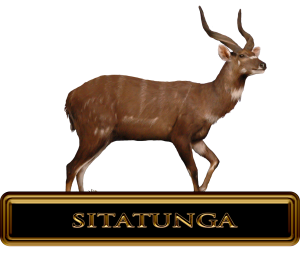
The Sitatunga is an amphibious antelope and strictly confines itself to swampy and marshy habitats. Sitatunga is known to submerge themselves in water right up to their nostrils, they also have splayed hooves which improves their swimming ability and enables them to walk on floating islands of vegetation. The Sitatunga has a coarse-haired coat with a shaggy appearance and is covered in an oily, water repellent secretion. There are three subspecies of Sitatunga found in Africa namely the; east African or Nile Sitatunga, Congo/Forest Sitatunga and the Zambian/Southern Sitatunga. All three species look almost identical, they are however classified according to their geographical distribution.
The East African or Nile Sitatunga is found in wetland areas of Tanzania, Uganda, Rwanda as well as the Kivu province of the Democratic Republic of Congo( Adjacent to Rwanda). These sitatungas use regular tunneled pathways through the papyrus swamps and tall reeds. Considering the area where these animals occur the best method to hunt the East African sub specie is usually from an elevated blind or even a boat.
The Forest Sitatunga is found in the forests of Cameroon and the Central African Republic. This sub specie provides for rather tricky hunt as these forest Sitatungas confine themselves to some of the most dense areas of the forest. Pygmy trackers are used to track these animals and then and the use of dogs to bay the animal once spotted, very similar to hunting the bongo. The bay does not last long and if the animal gets even a glimpse of the hunters it will break the bay and disappear into the thick stuff.
Zambian Sitatunga are found in Botswana on the Okavango swamps as well as in Zambia throughout lake Bangweulu Swamps. Hunting these animals can be done by drifting slowly on the swamps in a wooden dugout canoe, from a hollowed-out tree. It is an incredibly silent way of covering good distance in the swamps-very silently. The animals do not hear you coming, although the 50-75 yard shot can sometimes be tricky while floating along.
The best time to hunt sitatunga are the early hours in the morning and late afternoon as this is when they are most active. Sitatunga rest during the hotter part of the day usually on flat reed beds, it is also worthy to note that these animals seldom leave their swampy habitat and follow a general routine.
Small family groups may be found although mature males are usually seen alone or with another younger male. It is very common in sitatunga that the individuals associate with the same sex, especially when the females are caring for their young. Sitatunga are not territorial, makes do fight amongst one another to gain mating rights on the females, this is however not to protect their territory.
When Hunting Sitatunga one should be prepared to take a quick accurate shot. Depending on the method used whether it’s from a dugout canoe or from an elevated blind. The first shot needs to count as the follow up on any animal in the swamp can be very tricky. A blood track is extremely difficult to follow the swamps due to the water dissipating the blood as soon as it falls and when an animal does go down it may be submerged.
A Bull Sitatunga with good horn length and thick bases will make a good trophy. Although just being able to take one of these fine animals is a trophy on its own. The horns are very similar to those of the Nyala, and a good bell shape which extends past the ears will score well.
If you are looking for a great Sitatunga hunt in Africa, give us a call or fill out the form below and let us help you find the perfect sitatunga hunt for you.
Legacy Outdoors
Offices In:
Idaho, Wisconsin, Alberta, Illinois, Texas, Pennsylvania